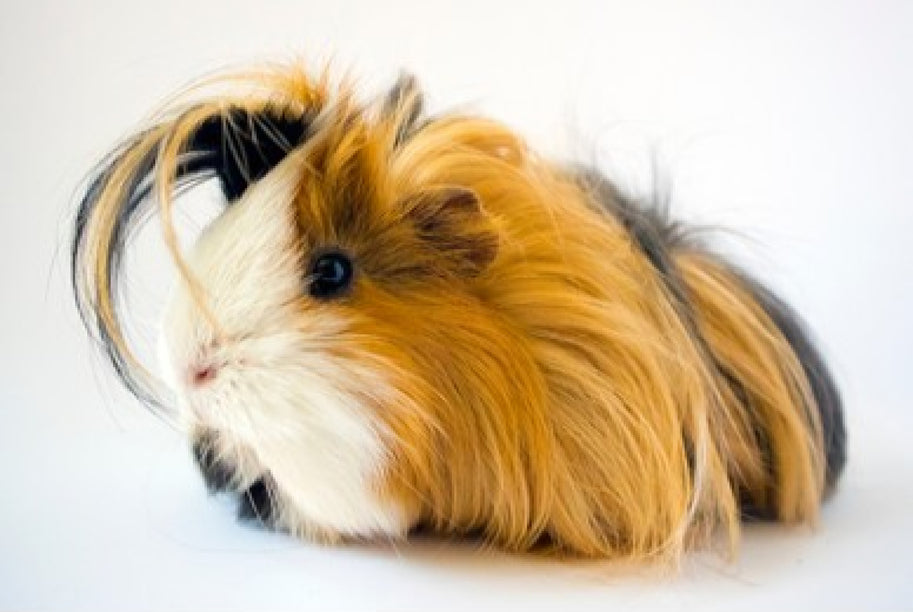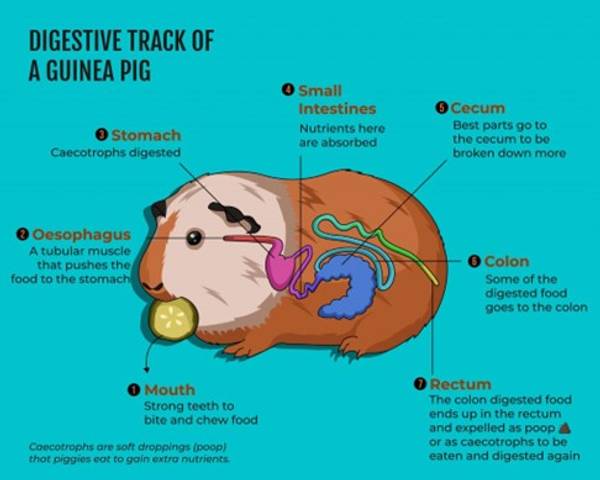When we talk about animal nutrition, I always like to start with looking at the animal’s digestive system first. The reason for this is because if we understand how the digestive system of the animal works and functions, we are better equipped to make logical and educated decisions about what to feed them.
Cavies are strict herbivores (i.e they only eat plants) and their digestive system is somewhat similar to rabbits and horses and are classified as hindgut fermenters. Overall, the guinea pig’s digestive system is pretty amazing – but also very delicate! The wild guinea pig, in its native habitat of the South American forests, eats a variety of foods, everything from fruits to leaves and plants to root vegetables, but especially a lot of high-fibre grasses.
Now imagine surviving on a diet that consists of mostly grass and hay! Fresh green grass or hay is perfect for Cavies, but it isn’t exactly full of energy.
However, guinea pigs have developed a highly specialised digestive system that enables them to live and thrive on this amazing ‘Green’ fibre source. Pet guinea pigs are often fed a dry guinea pig mix/pellets with the occasional bit of fresh vegetables, which is inadequate in fibre and generally too high in carbohydrates. Hay is critical not only to help wear down their continuously growing teeth, but also to keeping the bacteria in their intestinal tract that ferment their food healthy.
Before we look into the capabilities of the digestive system, let’s start at the beginning. The first thing that gives cavies the ability to eat grass and ferment fibre all day is their incisors and molars (teeth) and the production of saliva. Since guinea pigs need to munch, munch, munch, they have ‘open rooted’ teeth that continually grow to compensate for all the constant munching and grinding. This is why good dental health is so important.
Having the ability to grind down grass and hay allows the large intestine to start the fermentation process. As hind gut fermenters, guinea pigs digest much of their food in the caecum and colon (large intestine) which are at the end of the digestive tract.
Looking at the diagram of the digestive system below, we can clearly see that the caecum is the largest organ in the tract. The caecum, a thin-walled sac located at the junction of the small and large intestine and contains up to 65% of gastrointestinal (GI) contents giving it the biggest job to do. Within the caecum, healthy microbes - bacteria and protozoa, aid digestion. These ‘friendly bacteria’ are the secret to success for cavies, as they can help break down tough fibre and release lots of essential nutrients.

Now a ‘Fun Fact’ about the digestive system is that cavies need to practice coprophagy (ingestion of one’s own faeces) to assist in their overall health. A cavies fibre ‘nuggets’ (poo) are a great source of B vitamins, vitamin K and are the perfect means of optimizing protein utilization. By eating their own poo, guinea pigs can absorb all the goodness they missed out on the first time through the digestive tract.
Now when looking at the diet of your Cavy, it’s imperative that you keep in mind that the fibre content should always be higher than the protein content. When looking at commercial feeds, a good protein content is around 15-16% and the fibre content should sit above 20% - it’s a great rule of thumb to provide the highest fibre content possible (from grass and hay) and limit carbohydrates. Now caution should be taken when choosing an appropriate hay for your cavy. Lucerne and clover hays should not be fed due to their high protein and calcium content.
Now we all know that fresh green leafy vegetables and herbs are great for Guineas. Not only are they great fibre and are really tasty, but they can also provide a dietary source of Vitamin C. Cavies require 10-50 mg/kg daily to maintain good health. As most cavies are about one kilogram in weight, or a bit less, you will need to give each about 10-50mg of vitamin C a day.
Providing a daily source of vitamin C is essential, because like humans, cavies cannot produce their own. A deficiency in Vitamin C can lead to; a poor coat, swellings/sores around the mouth, delayed wound healings, poor appetite, lethargy, diarrhoea and difficulty moving.
Green leafy veg as well as foods like capsicums, carrots, berries, pineapples and kiwifruit are a tasty and effective way to add Vitamin C (but be careful not to overdo it as fruits are also very high in sugar – a few times a week is perfect!) It’s important to remember that Vitamin C has a half-life of approximately 10 days in vegetables. This means that from the point of being harvested, the amount of viable Vitamin C contained within the food decreases by half every 10 days. Always feed vegetables, greens and fruit as fresh as possible for maximum nutrient content.
If you want to use a supplement, you can add vitamin C to the water at the rate of 200mg per litre. However, it is widely advised that Vitamin C should not be added to water bottles as the vitamin degrades quickly in water and light, it can encourage bacteria to grow and the altered taste may prevent your guinea pigs from drinking at all. Also if the water container is an open dish, the vitamin C will decrease by half over a twenty-four hour period, so it is a lot more effective to feed Vitamin C rich foods.
Now that we’ve discussed the importance of fibre and a balance of hay and fresh fruits and vegies, let’s not forget about the importance of fresh water!
Fresh, clean water should be freely available. Sipper bottles are best cleaned daily, and their tubes should be checked for obstructions in the tips. Unfortunately water bowls are often not practical, as guinea pigs often soil their water with food or faeces or knock their bowls over. Food bowls should be heavy enough (ceramic is perfect) such that they are hard to tip over.
Thanks to Megan McKenzie, Brand Manager at Green Valley Grains for sharing her knowledge with us.






